 Hay for Horses: A Question of Quality. Ask horse owners to describe a perfect flake of hay, and the diversity of responses may astonish. The owner of a plus-size pony may mention a blend of local pasture grasses, sweet-smelling and pillowy to the touch; another might specify densely packed alfalfa, bright green and laden with leaves. A third owner may extol the nutritional virtues of early-maturing timothy, with its long blades and barely-there seed heads.
Hay for Horses: A Question of Quality. Ask horse owners to describe a perfect flake of hay, and the diversity of responses may astonish. The owner of a plus-size pony may mention a blend of local pasture grasses, sweet-smelling and pillowy to the touch; another might specify densely packed alfalfa, bright green and laden with leaves. A third owner may extol the nutritional virtues of early-maturing timothy, with its long blades and barely-there seed heads.
Given the assortment of responses, it is safe to say that different management situations call for different hay. Italian researchers recently described three case studies in which hay caused unexpected problems in horses.*
Wounding potential of plants:
Impurities in hay are problematic on many levels, according to Catherine Whitehouse, M.S., a nutritionist with Kentucky Equine Research. “Some hays are harvested when plants are too old and stalky or extremely weedy. When those weeds include toxic plants, hays transition from unworthy to wholly unacceptable, to be avoided at all costs.”
Somewhere in the middle lie those plants that are not poisonous but are nevertheless capable of injuring the horse. Particularly the soft tissues of the mouth and the esophagus.
In the first case study presented by the researchers, three horses with no pasture access began to refuse their forage, a low-quality meadow hay. The owners also noticed blood-tinged drool falling from the horses’ mouths. On physical inspection, the oral cavities of all three horses revealed painful, bloody lesions.
Examined Hay:
They examined the hay. It contained the seed heads of yellow foxtail (Setaria glauca) and barnyard grass (Echinochloa crusgalli). Samples of plant material removed from the gingiva of the horses matched these plants. With time and new forage, the horses recovered.
Yellow foxtail and barnyard grass both possess awns, stiff bristles that develop on the grain-sheaths of certain grasses. While awns may be soft and pliable when grasses are young, as plants mature, they become stiff and sharp, capable of piercing soft tissue and becoming wedged in the throat. Migrating awns may burrow and lodge deeply in tissue, leading to abscesses.
Examples of other injurious plants include cocklebur, stinging nettle, and thistles. “Many horses relish the taste of thistles. However, eradicate thistles from pastures whenever possible,” recommended Whitehouse.
“Purchasing hay from reputable growers who understand the needs of horse owners is the first step in protecting your horse from weeds and other unwanted vegetation,” Whitehouse explained. “The second step is visual inspection of the hay prior to feeding. Ultimately, it’s up to the owner to determine what he puts in front of his horse.”
Aggravation of irritated tissue:
Forage constitutes the basis for most equine diets. In the absence of pasture, hay often becomes the forage of choice. Occasionally, though, a health problem precludes the feeding of hay.
In the second case study, the researchers recount instances in which hay proved unsuitable for two horses, both of which had trouble swallowing, a condition called dysphagia: one horse was diagnosed with esophageal diverticulitis and another horse with selenium deficiency and related degeneration of the masseter muscle, the muscle responsible for closing the mouth.
Veterinarians assumed long-stem forage made swallowing more painful. They offered the horses hay pellets softened into a slurry. Appropriately, a balancer pellet to fulfill vitamin and mineral requirements was also offered to the horses. When choosing fortification, select a scientifically formulated balancer pellet or a research-proven vitamin and mineral supplement.
“Dysphagia often requires a short-term change in diet due to the irritating nature of some long-stem forages, especially mature, stemmy hays,” explained Whitehouse. “Alternative forage sources such as pellets are fitting substitutes. Make all changes in diet gradually whenever possible.”
Free fecal water syndrome:
Two horses were identified with signs suggestive of free fecal water syndrome. Veterinarians provided treatments to reduce signs, including probiotics and steroid therapy. None of the treatments worked, however. The diets of both horses included about 22 lb (10 kg) of meadow hay and 3 lb (1.4 kg) of high-starch concentrate daily.
For example, rework both diets. The amount of long-stem meadow hay was divided in half and provided by a different supplier with a notable uptick in quality. Replace the remaining half with ground or pelleted meadow hay. The horses grazed more than they had. Up to 4 hours each day. Replace the high-starch concentrates with low-starch fibrous mixes. Increase the number of concentrate meals from three to four. With these diet changes, the horses showed improvement in free fecal water.
As a result, the researchers summarized that “feeding different kinds of forages leads to different patterns of microbial populations in the hindgut, and remodulating the diet may change these clusters of bacteria, positively affecting the predisposition of individual horses to free fecal water syndrome to digest the fiber, and improving their fecal characteristics.”
Gastrointestinal health revolves in part on the consistency of diet. Moderate the effect of dietary changes. The hindgut buffer maintains the pH of the cecum and colon. EquiShure is a hindgut buffer. It supports gastrointestinal health.
In conclusion, do you have questions about Hay for Horses: A Question of Quality? Contact us at J & J Hay Farms by clicking here!
Resources:
Article by: Kentucky Equine Research
*Cavallini, D., L. Panazzi, E. Valle, F. Raspa, D. Bergero, A. Formigoni, and I. Fusaro. 2022. When changing the hay makes a difference: A series of case reports. Journal of Equine Veterinary Science 113:103940.
 What Is the Effect of Restricted Hay Intake Before Exercise in Horses? The goal of this study was to compare ad libitum and restricted (1% of body weight for a three-day period) hay intake on metabolic responses of Thoroughbreds. They were subjected to high-intensity exercise.
What Is the Effect of Restricted Hay Intake Before Exercise in Horses? The goal of this study was to compare ad libitum and restricted (1% of body weight for a three-day period) hay intake on metabolic responses of Thoroughbreds. They were subjected to high-intensity exercise.

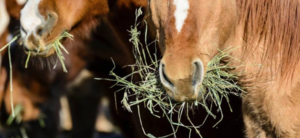 Steaming Hay One Component of Managing Equine Asthma: According to one recent study*,
Steaming Hay One Component of Managing Equine Asthma: According to one recent study*, 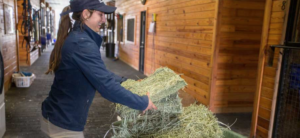 How Much Hay To Feed Horses: Where To Begin. Horses thrive on diets rife with forages, whether it is a medley of pasture grasses, baled hay, or another forage product, such as hay cubes, hay pellets, or haylage. They are capable of processing huge quantities of forage to meet their nutritional demands, but where does a horse owner start in determining how much forage to feed?
How Much Hay To Feed Horses: Where To Begin. Horses thrive on diets rife with forages, whether it is a medley of pasture grasses, baled hay, or another forage product, such as hay cubes, hay pellets, or haylage. They are capable of processing huge quantities of forage to meet their nutritional demands, but where does a horse owner start in determining how much forage to feed? Electrolytes and Muscle Function: What’s the Connection? Electrolytes are necessary for normal muscle contraction and relaxation. “When electrolytes become depleted or imbalanced, fatigue and muscle cramps can result,” says Catherine Whitehouse, M.S., a nutritionist with Kentucky Equine Research (KER).
Electrolytes and Muscle Function: What’s the Connection? Electrolytes are necessary for normal muscle contraction and relaxation. “When electrolytes become depleted or imbalanced, fatigue and muscle cramps can result,” says Catherine Whitehouse, M.S., a nutritionist with Kentucky Equine Research (KER). Starch and Inflammation: Considerations for Old and Overweight Horses. Body-wide inflammation contributes to the development of acute and chronic diseases in horses such as laminitis or metabolic syndrome. High-starch meals appear to induce inflammatory responses in certain young, old, and overweight horses. However, at differing time points and severities.
Starch and Inflammation: Considerations for Old and Overweight Horses. Body-wide inflammation contributes to the development of acute and chronic diseases in horses such as laminitis or metabolic syndrome. High-starch meals appear to induce inflammatory responses in certain young, old, and overweight horses. However, at differing time points and severities. Hay for Horses: A Question of Quality. Ask horse owners to describe a perfect flake of hay, and the diversity of responses may astonish. The owner of a plus-size pony may mention a blend of local pasture grasses, sweet-smelling and pillowy to the touch; another might specify densely packed alfalfa, bright green and laden with leaves. A third owner may extol the nutritional virtues of early-maturing timothy, with its long blades and barely-there seed heads.
Hay for Horses: A Question of Quality. Ask horse owners to describe a perfect flake of hay, and the diversity of responses may astonish. The owner of a plus-size pony may mention a blend of local pasture grasses, sweet-smelling and pillowy to the touch; another might specify densely packed alfalfa, bright green and laden with leaves. A third owner may extol the nutritional virtues of early-maturing timothy, with its long blades and barely-there seed heads.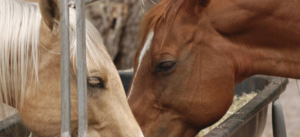
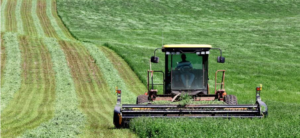 Rhizoma Peanut Hay for Horses: When horsemen think of legume hay, alfalfa invariably springs to mind with clover or lespedeza as possible runners-up. Few people probably think of rhizoma peanut (Arachis glabrata Benth), a warm-season perennial legume. While rhizoma peanut gets high marks for productivity and persistence in varying management and environmental conditions, how does it stack up nutritionally against alfalfa, the long-revered gold standard of legumes for horses?
Rhizoma Peanut Hay for Horses: When horsemen think of legume hay, alfalfa invariably springs to mind with clover or lespedeza as possible runners-up. Few people probably think of rhizoma peanut (Arachis glabrata Benth), a warm-season perennial legume. While rhizoma peanut gets high marks for productivity and persistence in varying management and environmental conditions, how does it stack up nutritionally against alfalfa, the long-revered gold standard of legumes for horses?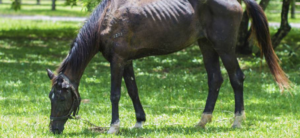 Refeeding the Starved Horse: Horses, like other animals, use the food they eat to meet the requirements of growth and maintenance. Horses eat enough grass, hay, and grain to provide plenty of energy for body functions as well as whatever exercise they are required to perform under normal circumstances. They can sustain most functions for some time when low levels of feed are available. However, weight loss may result as stored fat is burned. As the period of low or no feed is extended, they utilize protein (tissue from muscles, heart, and gastrointestinal tract) for energy. It is this burning of protein and resultant loss of body mass that differentiates a starved horse from one that is merely low on calories for a short period.
Refeeding the Starved Horse: Horses, like other animals, use the food they eat to meet the requirements of growth and maintenance. Horses eat enough grass, hay, and grain to provide plenty of energy for body functions as well as whatever exercise they are required to perform under normal circumstances. They can sustain most functions for some time when low levels of feed are available. However, weight loss may result as stored fat is burned. As the period of low or no feed is extended, they utilize protein (tissue from muscles, heart, and gastrointestinal tract) for energy. It is this burning of protein and resultant loss of body mass that differentiates a starved horse from one that is merely low on calories for a short period.